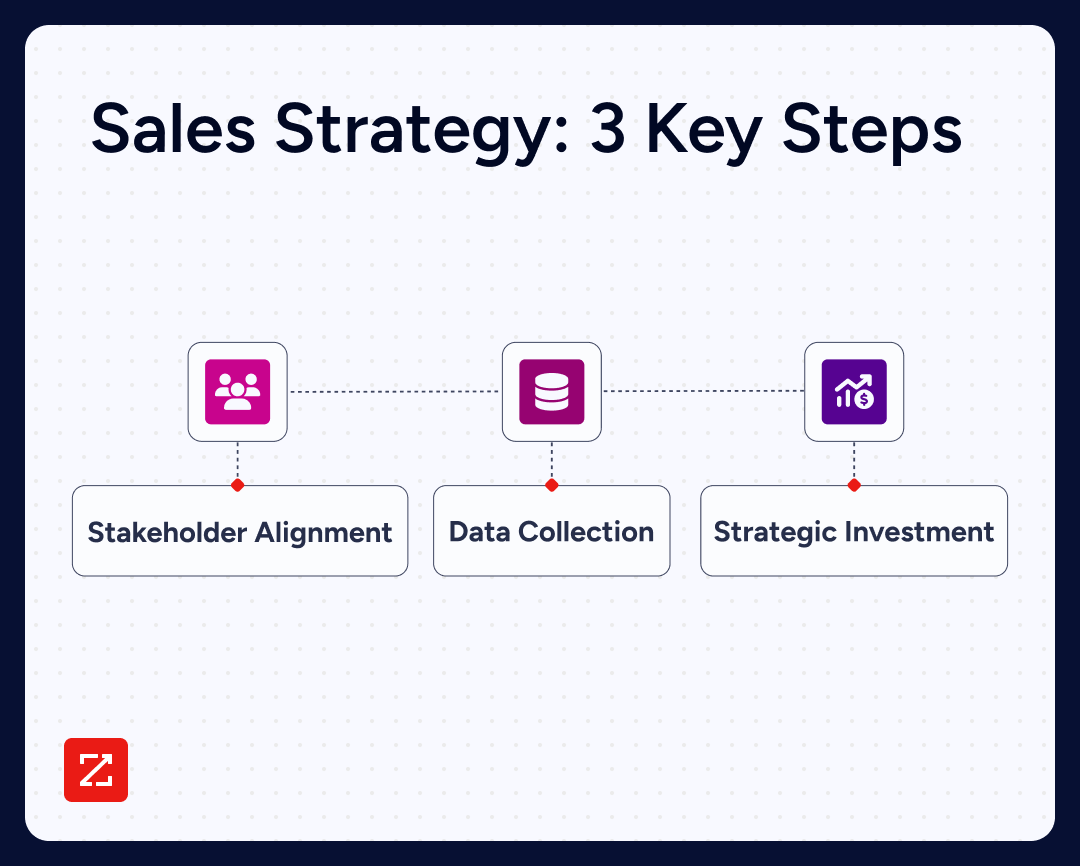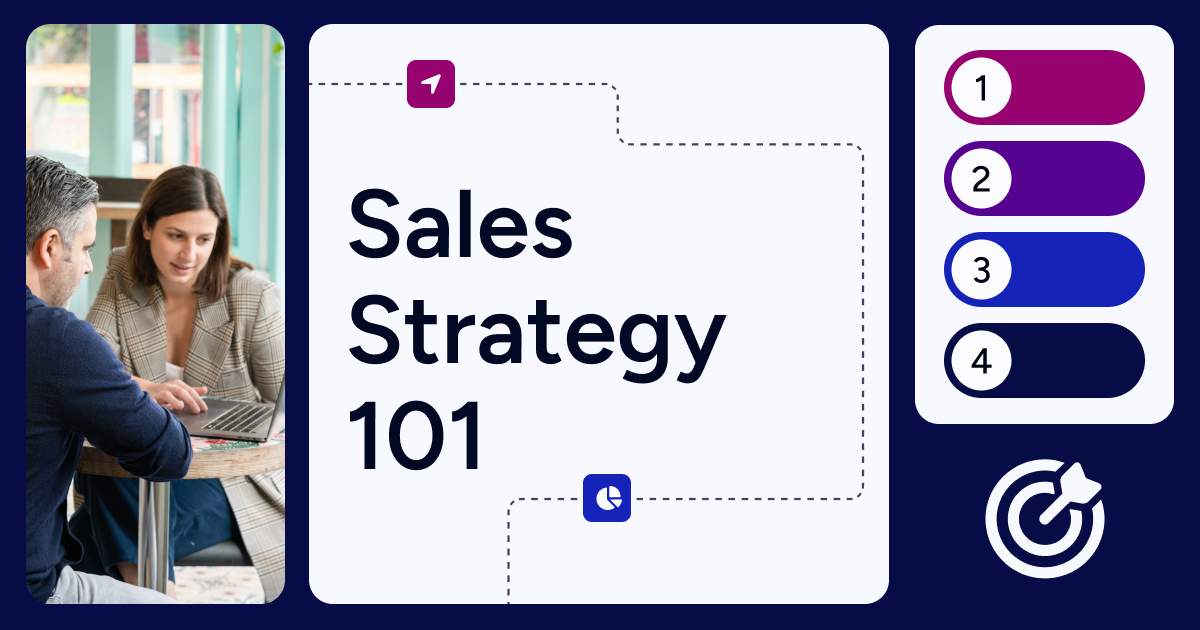When developing a sales strategy, many leaders aren’t sure where to begin. There are various stakeholders, priorities, markets, and channels to align, and the right mix for your business may not always be clear.
Whether you’re starting from scratch or looking to revamp an existing sales strategy, creating campaigns based solely on instincts or assumptions is no longer acceptable. To craft an effective modern sales playbook, data and analytics must reign supreme. There’s no shortage of valuable information about prospects and customers — as long as you know how to access and apply it.
Let’s explore the definition of a sales strategy, what makes a strategy successful, why accurate data is essential, and how to go about developing and refining a winning sales approach.
What is a Sales Strategy?
What’s the Difference Between Inbound and Outbound Sales?
When building a new sales strategy, it’s important to determine whether you will prioritize inbound sales or outbound sales.
Inbound sales are when customers initiate contact with your business to inquire about the product or service you sell. You educate the customer about your brand through different engagement tactics and channels. They decide when to reach out to you and start the conversation.
A classic inbound sales tactic is working with the marketing department to create a blog post and social series about the power of your product. The goal of the campaign is to get a target contact to click on the call-to-action and request a demo or free trial.
Outbound sales are when your reps identify and proactively reach out to potential customers who might be interested in buying your product or service.
One example of an outbound sales tactic is the triple touch process, where reps work to connect with prospects through a series of personalized messages. The goal is always for a prospective customer to agree to a call with your sales rep to learn more about your product or service.
What makes a sales strategy effective?
A sales strategy is successful when it portrays clear value to prospective customers. In order to provide that value to your customers, you need to understand the challenges and problems they face and how your team can help them.
Once you understand their needs, it’s important to create a sense of urgency around your product with the prospect. Focus on a sales pitch that explains how your product or service will help them successfully overcome their day-to-day challenges.

How to create a successful sales strategy
In order to create a successful sales strategy, sales leaders must align with the necessary stakeholders, collect and analyze the right data, and effectively leverage their investments in talent and technology.
1. Align with key stakeholders
A successful sales strategy starts from the top down. Corporate leadership must prioritize and communicate the importance of cross-functional alignment, for any sales strategy to catch on. Securing executive buy-in is often easier said than done. But with the right approach, you can demonstrate the value of an effective sales strategy in just a few steps.
Here’s what we recommend:
Focus on revenue
A sales strategy may benefit your business in a number of ways beyond boosting revenue, but executives want to know how an effective, data-driven sales strategy will make your company more money. Be sure to come to initial strategy meetings with precise projections and goals that quantify the impact of your plan.
Analyze existing data
Dig into your customer database, your CRM, and any other marketing automation or sales enablement tools. Gather and analyze this data so you can prove how effective data-driven sales can be.
For example, you export and analyze data on your best customers and notice a correlation between average deal size and lead source. You see that buyers who were initially contacted via cold call spent the most money with your company. Then, based on the number of reps you have and the number of prospects within your target audience, you predict you could double revenue by hiring 10 more outbound sales reps to focus on cold calling.
This demonstrates how attainable and successful a data-driven sales strategy can be. Leaning into data can also help your teams to understand customer needs and identify prospects with high intent to purchase.
Find case studies
Perhaps you don’t have a ton of sales data at your disposal. That’s OK, everyone has to start somewhere. Consider researching other companies in your industry that have implemented effective sales strategies. Use their results to show executives what kind of impact to expect if they embrace the power of data.
Once all key stakeholders are on board, you must stress the importance of a data-driven mindset. It’s not enough to agree upon a strategy. You must also communicate the value of data within every department of your company — customer success, sales, marketing, IT, HR, etc. Each plays a vital role in data collection and maintenance, and each can impact your company’s revenue.
2. Prioritize data collection and analysis
Data is a key component of any successful sales strategy. However, 45% of sellers say their biggest challenge with data is accuracy. It’s important for businesses to invest in high-quality data that can help reps cultivate better relationships with prospects.
Becoming a data-driven company isn’t a small transition to make. It means not just collecting and having data, but analyzing it and putting your insights into action. It requires distinct and detailed planning, with input from every department in your company.
Here’s what it takes to get your data-driven sales strategy up and running.
Sales calls
Use sales call intelligence to analyze data on your top-performing sales reps. See if you can identify trends that suggest certain practices, pitches, and questions that create better sales motions. Use those trends to tweak your future training programs.
Productivity
Research shows that sales reps spend only 28% of their week selling, down from 34% in 2018. How much time do your reps waste on menial tasks like data entry, scheduling meetings, and responding to emails? Use this information to inform your technology strategy — search for products that can streamline your reps’ processes and increase sales productivity.
Lead scoring
Lead scoring is a system in which you assign point values to each lead or prospect, based on specific criteria, to prioritize leads and improve outreach. By analyzing data, you can decide which data points indicate the likelihood of a purchase and assign them a higher point value. These data points may include demographics, point of entry, behavioral data, and more.
Personalization
Social selling
Collect data regarding prospects’ social media behavior, including which platforms they use and what types of content they share. Social media has become a key prospecting tool and data can help you understand how to use these platforms more effectively.
Marketing alignment
Analyze customer data to learn which content and messaging resonates most with your prospects. Regularly share these insights with your marketing team, so they can create relevant content to expand and support your sales outreach.
The list doesn’t end there. Data can be applied to every aspect of your sales strategy. Get creative!
3. Focus on strategic investments
An effective sales strategy isn’t something you can just set and forget. How you gather and use data will inevitably change as your business evolves and new technologies emerge, making ongoing team training a priority.
Invest in integrated technology
Technology plays a major role in effective, data-driven sales — it’s the glue that holds everything together. If your tools don’t integrate with each other, you won’t be able to share data across platforms, and you’ll likely lose track of important information. For this reason, you must build your sales tech stack carefully, in a way that supports your data-driven sales objectives.
Take a look at the tools and technologies that your sales team is using. Which ones are essential to your business and which ones can be consolidated, replaced, or removed?
Which ones don’t connect easily and seamlessly, and make managing data between platforms difficult? This includes the software used at each step in the buyer’s journey, from sales and marketing, to customer service.
It’s important to ask your sales reps for feedback on the technologies that they are currently using. Consider their input before making any decisions. Sit down with your top reps and discuss their preferences, concerns, and what they’re looking for most in a tech stack.
Provide ongoing sales training
A recent survey by McKinsey found that 97% of respondents view upskilling their sales force as a top priority.
Ongoing training is beneficial to any sales team, but it’s especially essential for an effective sales strategy. Not only does training keep your reps up to speed, but it also reinforces a data-driven mindset.
We recommend that you invest in training strategically — using data, of course. Analyze the performance of your reps and also the average sales cycle. Is there a particular point where most reps get tripped up or lose deals? Focus your training on those areas.
Key Takeaways
Building and implementing an effective sales strategy will look different for every business. Your teams need to determine the best approach based on your business goals. The good news is that data can help paint a clear picture of the sales approach that will resonate the most with your prospects.
While sales strategies vary, there are three main priorities to focus on:
Aligning with internal stakeholders and getting executive buy-in.
Leaning into data collection and analysis and pivoting as needed.
Focusing on strategic investments to make your teams work smarter, not harder.
There you have it — your guide to developing a successful, more data-driven sales strategy. It may sound like a lot to grasp, but an effective sales strategy will set your teams up for success in the long run. Time to get started!


